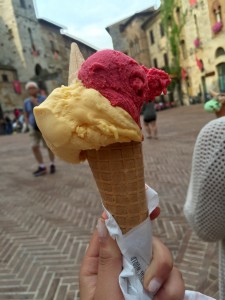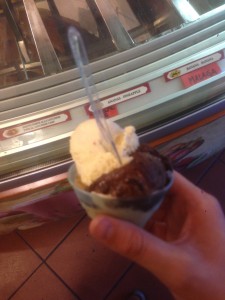
A Cone from Gelateria dell’Olmo
Introduction
The very first reading that we covered in class, The Pleasures of Eating by Wendell Berry, introduced us to the concept that we have been looking at food the wrong way for most, if not all of our lives. He describes our lack of understanding when it comes to the way in which our food is produced, and how this leads to many of the issues he sees today in the global food system. They are as follows: inhumane practices on farms, the rise of processed food, a decline in caring for what we eat, declining health, and the general commercialization of cuisine. He even goes so far as to suggest a list of solutions, recommending that we participate in agriculture, cook our own food, learn about farming and species, and educate ourselves on the global economy of food. These all sounded like noble ideas to me, and they were even nobler in practice. Gelato producers like Edoardo in Florence, De’ Coltelli in Pisa, and Caffetteria Gelateria dell’Olmo in San Gimignano provided a high-quality product using the best ingredients, sourced with an expertise that exhibited itself in the quality of the gelato. When we got to Sandler’s concerns about the global food system, however, I began to wonder about exactly who was producing these ingredients. After grappling with the ethical quandary of meat production, I knew that gelato couldn’t possibly be so simple. In this paper, I will explore the production of two main ingredients in gelato making, vanilla and cacao, examining their effect on the countries and farmers that choose to produce them, and how that information affects the global market for ingredients and gelato as well as the moral affect it has on us as consumers.
Methods of Production
Cacao trees grow largely on small farms in areas near the equator. Surprisingly, 80 to 90% of its production takes place on a small-scale. They are very delicate trees and require strict protection and cultivation, reaching their peak pod production at five years and sustaining this for another ten. They usually have two harvest times per year, largely variable and dependent on climate. Farmers harvest with long sticks, then split open the pods to remove the beans. They are then packed away to ferment for three to seven days before they are sold to an exporter (Foundation). Vanilla also must be produced in equatorial regions. It is the world’s most labor-intensive crop, making it one of the most expensive. The plant is a vine, growing on whatever it can find. It needs to grow for at least three years before in can produce beans. The beans are picked when they are still green then undergo a treating process to extract their flavor for what could be a few weeks to even months. Farmers do so by treating them with hot water and placing them in the sun. They then spend a month or two resting to continually develop flavor. Finally, they dry and are shipped off (Hachmann).
Market Overview
Africa produces the largest percentage of the world’s cacao, 68%, followed by Asia at 17%, and the Americas at 15%. Within these continents, the largest producers can be found in Cote d’Ivoire, Nigeria, Ghana, Indonesia, Brazil, Ecuador, and Colombia. The United States, Germany, the Netherlands, Belgium, France, and Spain are the largest demanders of cacao (Foundation). Cacao futures are traded on the NYSE and the Intercontinental Exchange. It is currently selling for $3153 per metric ton on the latter (ICE). It tends to be less volatile than other major commodities like wheat. Currently, the price is fairly average. Much less financial information is available about vanilla. We know the largest producers are Uganda, India, Indonesia, Papua New Guinea, and Madagascar. Prices have surged lately as a result of a poor harvest. Vanilla was selling for around $220 in April (Hachmann). The World Bank predicts that commodity prices are likely to fall for the remainder of 2016, continuing a downward trend that lately has killed producers. They provided the following information in their latest report, “Agricultural prices have been revised lower, and are projected to decline 4 percent in 2016 with prices falling in most commodity groups. This agricultural price outlook reflects adequate supplies in anticipation of another favorable crop year for most grain and oilseed commodities. Agricultural commodity markets are also aided by lower energy costs and plateauing demand for biofuels. The largest price drop is for grains and beverages (-5 percent each) and oils and meals (-3 percent). Other food items and agricultural raw material prices are expected to fall as well” (World Bank). They note that countries that heavily expanded production based off of surging early 2000s prices are now feeling the effects of oversupplied markets.
Consumer Effects
In 2015, the average retail price for an ice cream was $3.75. In contrast, most gelato places that I have seen in Italy charge around 2 or 3 euros, depending on the size. This difference can partially be attributed to change in portion size, as an American ice cream cone is usually about three or four scoops, making it a large in Italy. In general, U.S. ice cream prices have risen over the last ten years from $3.69/half gallon in 2005 to $4.73 in 2015 (Statista).

My first gelato at Edoardo

A Blurry Picture of an Average Gelato, This One from Lucca
Conclusions
In a world where ingredient prices are low and developing countries are experiencing losses on commodity production, how are consumers still paying increasing amounts for ice cream? It could be the prices of the other inputs, namely dairy or sugar. One possible theory is that the industrial processing of the ice cream adds too much to the price. In Italy, a producer like De’ Coltelli can afford to make his own gelato in-house, with fresh and delicious ingredients, while paying several employees. His processes are simple, using only six ingredients: milk, cream, eggs, sugar, flour, and locust bean seeds (Gelato Artignale). Edoardo also produces gelato that is free of additives, coloring, preservatives, and the other mysterious ingredients that commonly grace the fine print of our American ice creams (Gelato Biologico). We’ve established the fact that we can feel good about the ingredients of this gelato, but can we feel good about where they came from? Or how they were produced? How did their production affect the local economy of the likely developing country where they were grown? These questions are often heard in modern society and represent the views of an increasing number of “responsible food advocates.” We heard their arguments in James McWilliams’ Loving Animals to Death when it came to the responsible production of meat. McWilliams points out the obvious contradiction in such a situation: it cannot possibly be moral to raise an animal kindly and affectionately knowing the whole time that you plan on killing it. The same logic can be applied to gelato. It seems contradictory to ask all of these questions about the ingredients and production while ignoring the inherently exploitative nature of most of these businesses. If none of the proceeds of your artisan gelato make it back to the peasant farmer who picked the cacao beans that made the flavor, how can we be acting morally? Similarly, how can we bet on the future pricing of a metric ton of cacao, when the vast amount of money this speculation makes has no direct affect on those who enable it? Sandler mentions the problem of food sovereignty in Food Ethics, describing it as the ability of a region make its own decisions regarding its own food and agricultural products/processes. When we speculate on the price of cacao, say by buying a large futures contract, we may indirectly affect the market value. This will then lower the price and hurt producers; something they have no control or even knowledge of. I believe a practical solution harkens back to Berry’s suggestions. When we learn about where our food comes from, we cannot be too simplistic. There will always be someone who is willing to sell you an “authentic and organically produced” product. Or maybe even a chocolate product that supposedly gives back to the cacao producers. As long as we are learning, we are making progress. If enough people educate themselves, it may be enough for a serious change. However, we must also avoid over-adherence to these guidelines. It is simply not practical to research the sourcing of everything you buy, and even then someone may just be putting on a very good disguise. Like many things in life, it has occurred to me that balance is key.
Works Cited
“Cocoa Futures.” ICE-InterContinental Exchange. N.p., n.d. Web. 15 June 2016.
“Cocoa Market Update.” World Cocoa Foundation. N.p., n.d. Web. 15 June 2016.
“Commodity Markets Outlook.” World Bank. N.p., n.d. Web. 15 June 2016.
“Ice Cream and Gelato Category Average Price per Unit United States by Segment, 2015 | Statistic.” Statista. N.p., n.d. Web. 15 June 2016.
“Ingredients.” Gelato Artigianale Con Ingredienti Naturali. N.p., n.d. Web. 15 June 2016.
“Semplicemente Buono.” Gelato Biologico. N.p., n.d. Web. 15 June 2016.
“Vanilla Market Report NO. 48.” Aust Hachmann. N.p., n.d. Web. 15 June 2016.
